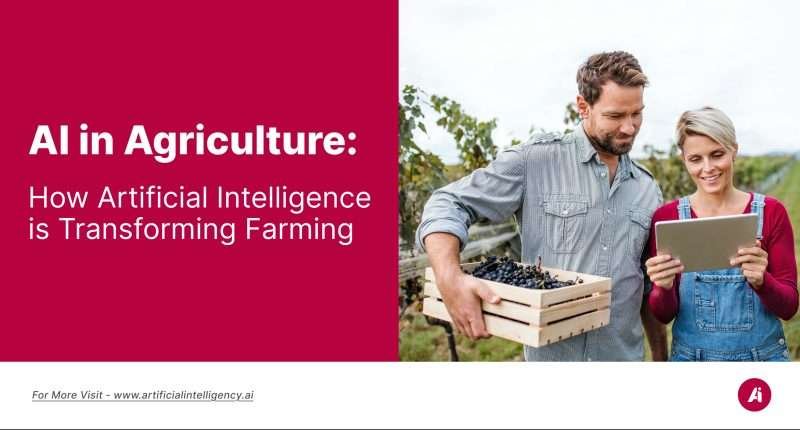Farming isn’t what it used to be—and that’s a good thing. With AI in agriculture leading the charge, we’re seeing a new era of intelligent, efficient, and sustainable farming. It has now become less guesswork and is based on much more precision than what we are used to. From planting to harvesting, AI-powered farming technology is helping farmers make data-driven decisions that actually work.
The best part? This isn’t some far-off future. Artificial intelligence in farming is already here, making real change on real farms. Tools powered by machine learning in agriculture are helping farmers monitor crops, predict yields, and respond to threats faster than ever.
It’s like having a tech-savvy farmhand that never sleeps! Let’s explore the wide-ranging benefits and powerful real-world applications of AI that are redefining what it means to farm in the 21st century.
Benefits of AI in Agriculture
Data-Based Decisions
One of the most impactful ways AI benefits agriculture is by turning vast amounts of raw data into actionable insights. Through advanced data processing, farmers can now assess everything from soil quality to market demand in real time. This means better decisions around planting schedules, crop rotation, and resource use. The application of AI in precision agriculture makes it possible to tailor every action to the specific needs of the land, leading to healthier crops and more sustainable practices.
What takes this to the next level is the use of machine learning in agriculture, which allows systems to learn from past seasons and adjust recommendations accordingly. These intelligent tools don’t just analyze—they adapt. This makes them an invaluable resource for improving efficiency and reducing trial-and-error in farming practices.
Cost Savings
Managing a farm is a costly venture, but AI is helping to ease that financial burden. By optimizing resource use, artificial intelligence helps minimize the overuse of water, fertilizers, and pesticides. With smart systems in place, farmers can avoid blanket applications and instead apply inputs exactly where and when they’re needed. This approach not only saves money but also limits environmental harm, preserving soil health for future growing seasons.
In this context, smart farming with AI enables farmers to manage budgets more effectively. AI systems can predict input requirements, anticipate potential crop failures, and reduce losses by detecting problems early. The end result is a leaner, more cost-effective farming operation supported by data-backed strategy.
Automation Impact
One of the most visible benefits of AI in agriculture is the rise of automation. Tasks that once took days can now be handled in hours using autonomous machinery and intelligent tools. From sowing seeds to spraying crops, AI-powered farming technology is reducing labor demands and increasing consistency in the field. These machines operate with remarkable precision, avoiding the inconsistencies that come with human fatigue or error.
When paired with the wider spectrum of AI applications in agriculture, automation ensures that repetitive, time-consuming work doesn’t limit a farm’s output. It also frees up time for farmers to focus on higher-level planning and problem-solving, helping them evolve from laborers to data-driven agricultural strategists.
Applications of Artificial Intelligence in Agriculture
Optimizing Automated Irrigation Systems
Irrigation is one of the most critical elements of crop production, and thanks to AI-powered irrigation systems, it’s getting a major upgrade. These systems use real-time data from soil sensors, weather stations, and plant health monitors to determine exactly when and how much to irrigate. This targeted approach not only prevents overwatering and runoff but also conserves water, one of agriculture’s most precious resources.
The integration of artificial intelligence in farming brings a level of precision that was previously unachievable. Crops receive optimal hydration at the right time, improving plant health while reducing utility costs. In regions affected by drought or water scarcity, AI-driven irrigation systems are not just innovative—they’re essential.
Detecting Leaks or Damage to Irrigation Systems
Beyond managing water usage, AI systems can also monitor the health of the irrigation infrastructure itself. Using sensors and predictive analytics, AI can detect subtle anomalies in pressure or flow that may indicate a leak or blockage. This proactive detection helps prevent larger issues like crop flooding or water wastage, which can be incredibly costly if left unchecked.
By employing machine learning in agriculture, these systems get smarter over time—learning the normal behavior of irrigation lines and flagging issues faster and with higher accuracy. Combined with AI for crop monitoring, this ensures the entire water delivery process is both intelligent and resilient.
Crop and Soil Monitoring
AI systems equipped with drones and satellite imaging tools are making it easier than ever to monitor soil and crop health across vast areas. These systems collect data on moisture, pH levels, nutrient content, and overall plant vitality. By analyzing this data, AI in precision agriculture enables farmers to intervene early when something is off—whether it’s a nutrient deficiency or suboptimal soil conditions.
This kind of continuous, automated oversight supports long-term land health and enhances productivity. With broader adoption of AI applications in agriculture, farms can become not only more productive but also more environmentally conscious, preserving soil fertility for future generations.
Detecting Disease and Pests
Crop diseases and pest infestations have long been unpredictable, but AI is changing that narrative. Using high-resolution imaging and pattern recognition, AI can identify symptoms of disease or signs of pest damage before they spread. This gives farmers the advantage of early treatment, often before the issue becomes visible to the human eye.
AI in pest and disease detection is especially useful when combined with real-time climate and soil data, making predictions even more accurate. When integrated into a broader smart farming with AI system, this tech ensures that threats are managed proactively, safeguarding both crop quality and yield.
Monitoring Livestock Health
Artificial intelligence isn’t limited to crops—it’s playing a vital role in livestock farming as well. Wearable sensors and camera systems powered by AI in agriculture can monitor everything from an animal’s movement patterns to its feeding behavior and temperature. These tools can detect early signs of illness, stress, or injury, allowing for immediate care.
Farmers using AI-powered farming technology benefit from healthier animals, reduced veterinary costs, and improved productivity. This is particularly valuable in large-scale operations where manual monitoring would be time-consuming or impractical. With AI, every animal gets the attention it needs.
Intelligent Pesticide Application
Blanket spraying of pesticides is inefficient and often harmful to the environment. Today, AI allows for precise pesticide application by identifying the specific areas affected by pests and delivering treatments only where needed. This approach minimizes chemical use and keeps beneficial organisms in the ecosystem unharmed.
Through advanced AI in pest and disease detection, drones or robotic sprayers can apply treatments with pinpoint accuracy. Combined with smart farming with AI, this method drastically reduces pesticide costs, improves crop quality, and supports more sustainable agricultural practices.
Yield Mapping and Predictive Analytics
Planning for the future is a challenge in agriculture, but AI is making it easier. By collecting and analyzing data on weather patterns, soil conditions, planting dates, and crop varieties, AI can accurately forecast yields before the harvest even begins. This information helps with inventory planning, logistics, and even pricing strategies at market.
Using AI for crop monitoring, farmers can understand not only what they’ll produce, but why certain areas of the field perform better than others. These insights allow them to replicate successful outcomes in the next season. With comprehensive AI applications in agriculture, the guesswork is replaced with actionable data.
Automatic Weeding and Harvesting
Weeding is a time-consuming and labor-intensive task, but AI-powered robots are flipping the script. These machines use vision systems and machine learning to distinguish between crops and weeds, removing only the undesirables with high precision. This leads to less soil disruption and a cleaner crop environment overall.
On the harvesting side, AI-powered farming technology enables machines to pick fruit or vegetables at the perfect level of ripeness. This reduces spoilage, improves consistency, and boosts profitability. These innovations are shining examples of how artificial intelligence in farming is automating the toughest manual tasks.
Sorting Harvested Produce
After harvesting, produce needs to be sorted by size, color, ripeness, and quality—a process that AI is now streamlining. Using camera systems and learning algorithms, AI can grade fruits and vegetables far more quickly and accurately than human labor can. The system ensures that only the best products make it to market, while identifying damaged or subpar items instantly.
This use of machine learning in agriculture improves post-harvest efficiency and product quality. It also supports supply chain management, as farmers can provide real-time data on inventory to retailers. The integration of AI-powered farming technology at this stage boosts both reputation and revenue.
Surveillance
Security and oversight are essential in modern agriculture, especially for large farms with valuable equipment and livestock. With the help of AI in agriculture, surveillance systems can now detect unauthorized access, monitor animal movements, and identify potential hazards like fires or equipment failures.
Paired with broader AI applications in agriculture, these surveillance tools provide peace of mind. They allow for remote monitoring via smartphone or computer and can trigger real-time alerts for any anomalies—making it easier to manage farms securely, even from a distance.
AI Devices Used in Agriculture
AI-Powered Drones
Drones have become an essential part of precision farming, and when paired with AI, their capabilities skyrocket. AI-powered farming technology allows drones to scan entire fields in minutes, collecting real-time data on crop health, irrigation needs, and even pest presence. They can detect subtle changes in plant coloration, which may signal nutrient deficiencies or early disease symptoms.
As part of a larger AI for crop monitoring system, these drones help farmers take immediate, targeted action. The efficiency and scalability of this technology make it invaluable for large-scale operations where traditional monitoring would be slow and incomplete.
Smart Soil Sensors
Soil health is the foundation of any successful crop yield. That’s why smart farming with AI now includes intelligent soil sensors that constantly monitor moisture levels, nutrient content, and temperature. These sensors send data to cloud-based platforms, where AI algorithms interpret the information and recommend actions such as fertilization or irrigation adjustments.
Used widely in AI applications in agriculture, these devices help farmers avoid overwatering, prevent nutrient runoff, and better time planting schedules. The result is healthier soil, reduced input costs, and better long-term yields.
Automated Irrigation Systems
Today’s irrigation systems don’t just follow timers—they think. With AI-powered irrigation systems, watering schedules adapt based on real-time weather conditions, soil readings, and crop type. This ensures that plants get the exact amount of water they need without waste.
Such systems are a prime example of artificial intelligence in farming, especially in regions facing water scarcity. Farmers can monitor and control irrigation remotely, leading to greater efficiency, healthier plants, and significant resource savings.
Robotic Harvesters
Harvesting is one of the most physically demanding aspects of farming, but AI is making it more efficient and less labor-intensive. AI in agriculture has given rise to robotic harvesters capable of identifying ripened produce and picking it without damaging the plant. These machines work around the clock and maintain a consistent harvest quality.
When paired with AI in precision agriculture, robotic harvesters can adapt to different plant species and field layouts, maximizing productivity and reducing losses due to over-ripeness or spoilage. They also free up human labor for more strategic tasks, improving overall farm management.
AI Pest Detection Cameras
Catching pests early is critical, and that’s where AI in pest and disease detection comes in. Specialized cameras equipped with AI can detect the presence of pests or their damage patterns before the problem spreads. They scan fields continuously, identifying infestations with more accuracy and speed than human workers.
These cameras are often integrated with machine learning in agriculture, allowing them to get better over time. The result is more precise intervention strategies, lower pesticide usage, and a better understanding of field conditions—before it’s too late.
Final Thoughts
The use of AI in agriculture is not just a trend—it’s a transformative shift that’s redefining the future of farming. From decision-making to disease detection, and from irrigation to harvest, AI is proving to be an essential tool in the modern farmer’s toolbox. It brings scalability, precision, and intelligence to a field that has traditionally relied on manual labor and seasonal experience.
As artificial intelligence in farming continues to evolve, its accessibility and affordability are improving, making these tools viable even for smaller farms. The integration of devices like AI-powered drones, soil sensors, and robotic harvesters represents a leap toward a more sustainable, productive, and profitable agricultural industry. Farmers who embrace these technologies today are not just staying competitive—they’re building the resilient, efficient farms of tomorrow.



